Yakuza Wolf 2: Extend My Condolences, Yakuza Wolf: I Perform Murder (1972)
Directed by: Buichi Saitô, Ryûichi Takamori
Written by: Fumio Kônami, Ryuzo Nakanishi
Starring: Kôji Nanbara, Makoto Sato, Reiko Ike, Shin'ichi Chiba, Tsunehiko Watase
YAKUZA WOLF 1 AND 1 [1972]
JAPAN
AVAILABLE ON BLU-RAY: NOW, from EUREKA ENTERTAINMENT
REVIEWED BY: Dr Lenera
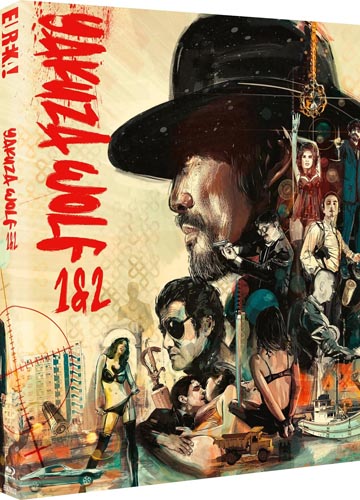
YAKUZA WOLF: I PERFORM MURDER [1972]
AKA OKAMI YAKUZA: KOROSHI WA ORE GA YARU
RUNNING TIME: 87 mins
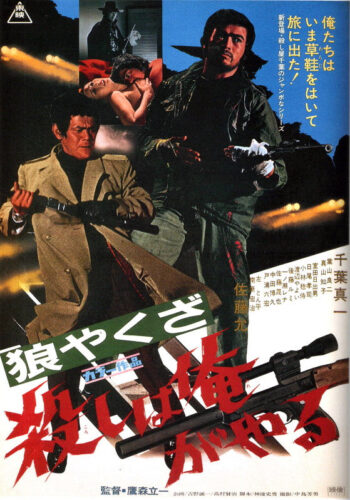
Five years ago Gosuke Himuro’s father, who was the leader of the Himuro clan, was murdered. Now he returns to Okinawa looking for his sister Kyoko and to avenge his father’s death. He starts to kill off members of the Onama clan, which killed his father, and might be getting closer to Kyoko, who was turned into a junkie sex slave by the Koyu-Kai clan, but he knows that not even a single man as powerful as him can defeat two clans on his own, so he decides to pit the two against each other. Detective Shimaoka also wishes to smash the gangs and gives Himuro carte blanche to deal with things as ruthlessly as he wants….
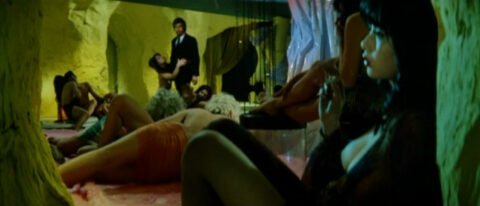
Eureka’s commitment to releasing Sonny Chiba films is a gift for old fans and has probably created new ones. I suppose I’d consider myself to be more in the latter category, seeing as I hadn’t even seen much of his work until recently. Now he’s not a guy whom I’d normally call a diverse actor, often tending to play variations of the same character in the same over the top style. However, I Perform Murder gives us a rather different Chiba than we’re used to. Okay, he’s not that different; he’s still a powerful instrument of revenge who isn’t always the nicest of guys. However, he doesn’t perform any real martial arts, and, more than that, he’s the strong, silent type, calm and really rather enigmatic as he lays waste to loads of bad guys in a variety of ways, and he does it well too. The obvious inspiration is, of course, Clint Eastwood’s The Man With No Name [I always chuckle at that moniker because, despite it being given to him by United Artists the American distributors of the Sergio Leone trilogy, in each of the films he actually does have a name], though a greater influence is Franco Nero’s Django, with even other things from the film of that title being imitated. The plot has elements of both while the movie blends in aspects of the spaghetti western to the yakuza thriller, and does it well, resulting in a rather edifying mix, as well as it just being a fine revenge actioner taken at a fast and furious pace with dollops of sex [which is surprisingly erotic in a genre that rarely attempts to be such] and violence. It perhaps shouldn’t surprise that it melds together so well, considering the strong links between the samurai picture and the western full stop, though things do seem rushed in a few places as we’re rushed helter skelter through its fairly solid if unoriginal plot, and the “shakycam” many of these films possess goes a bit over the top here in places.
We open with a closeup of hair and a hand stroking it before we realise that a man is in bed with this woman whom we first think is pleasuring herself. Blood comes pouring out from underneath and we were no doubt intended to think that this blood could be vaginal until we see that the woman has been stabbed and the man is next. Cut to another man running along a car park, and he’s knocked down by a car, then has his arm ran over. Cut to some gangsters rather annoyed that no less than twenty-two men have been killed. These guys are Onuma men, and wonder if “one of the few remaining Himuro” or an assassin hired by “Eguchi of the Koyu-kai”, their rival gang, did it. Two more Onuma hoods talk about how “Himuro would have never thought that his office would be replaced by a recreation centre” before one is suddenly killed buy a thrown knife and the other flees down a train track onto a field where we zoom out to reveal, in the foreground, the silhouetted legs of our hero in the first of many great introductions that he has. His quarry recognises him as “Himuro’s son”, and we flashback to a frantic scene where his father and sister Kyoko have a gang of yakuza burst in on them who, in the midst of a blazing fight with some of Himuro’s men, kidnap Kyoko and shoot dead Himuro. “I didn’t like my old man, I wanted to go and love on my own way” laments Gosuke. It seems that Gosuke is going to let the guy go, before shooting him in the back as he walks away, after which we cut to an amazing red-drenched shot of Gosuke walking during a sunset. Now we get the titles, and lots of footage of Gosuke walking, before he kills yet more men. He’s truly deadly this guy, and doesn’t even seem bothered that a cop on his trail shows up, fully knowing what he’s doing and, having “arrested some low level guy as a scapegoat”, is prepared to let him continue on his rampage and even tells him that his sister is still alive. “We’re keep watching him” says Detective Shimaoka to his rather shadowy partner, but all they’d need to do is to follow the trail of bodies.
While Gosuke just watches, a hooker is being dragged into a car by a gang who intend to rape her, though two of them get so excited that they come immediately in a “humorous” bit many will find to be in poor taste, though at least we’re shown now pathetic these guys are when they then go into a bar and boast about their prowess before encountering Gosuke. After a conversation with Onuma himself, he orders from the barman, who’s already had two drinks returned to him by Gosuke and Onuma which he’s told to drink himself, a woman. “I want her before they dope her up” he insists. He takes out his frustration on happy hooker Saeko but she rather likes it [“why did you do it so hard? Was it out of revenge, have you been fooled by a girl”?] and likes him, he reminding her of her first guy who got killed. However, he espies a medallion that belonged to Kyoko and has no bones about slapping her around to get the information that he needs. She got it from one Onuma’s men, but it’s now where Gosuke realises that he can cause more deaths much more quickly if he stirs and gets both gangs to battle each other, and battle each other they immediately do. This middle section could have benefitted from being given more time to develop, but then again the headlong pacing will be seen by some as one of this film’s strengths. With far more people out of the way, Gosuke will more easily be able to get to his ultimate targets and hopefully locate and rescue Kyoko. But how much will Shimaoka accept before he arrests Gosuke, a man so confident that he actually turns down information on his quarries because he knows he can get it himself. And what about Saeko? The character falls in love with our hero very quickly but is he even able to love? And what about Eguchi, the also pretty lethal Koyu-Kai head who seems to form a partnership with Gosuke; can he be trusted?
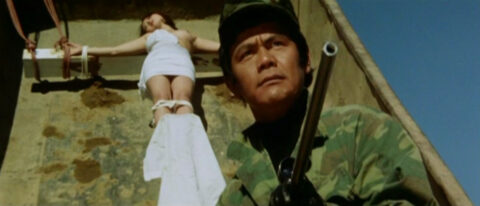
The blood flows thick and fast, though for much of the time Chiba’s character just kills off people suddenly and efficiently, wearing giallo-style black gloves in addition to and, unless you include a few kicks and blows here and there, he only gets one fight sequence which you shouldn’t expect much out of; it features no martial arts expertise and looks a bit clumsy until we remember that, in Japanese movies, the actors usually did all of their action scenes, with stunt people rarely being used, not to mention the fact that the Chiba archetype wasn’t a thing in cinema yet. Still, it’s strange to see Chiba in such a scene, we keep expecting him to suddenly cut loose and he doesn’t. A shootout in and around a tyre dump yard is well done, and probably the most western-like of the many action scenes, but the mass brawls have the camera wobbling so much that it looks like we’re watching a Found Footage flick, though one can still sometimes tell that the choreography isn’t all that; in any case, Kinju Fukusaka would make that style into something much better in his Battles Without Honour And Humanity series. Elsewhere cinematographer Yoshio Nakajima’s work is very good indeed, sometimes very film noir-influenced with good use of shadow and darkness, plus some striking shots, such as when Shimaoka is with a dead body in the foreground while Gosuke is slowly walking away in the background in heroic fashion. The image of a kidnapped woman returned in a Christ-like pose in the back of a dump truck is also memorable. Then there’s a rather memorable sequence in a brothel as the camera, and we, explore the green-drenched place and linger on whatever decadent things are going on before finally alighting on who Gosuke is looking for. The sex scenes are largely shot in partial darkness and contain a lot of closeups which don’t have much rhythm to them, but they have a surprising charge to them, as if Ryûichi Takamori was geninely trying to turn on an audience, and female viewers as well as male.
Fumio Kônami’a screenplay doesn’t have time to provide much characterisation, though it does surprisingly try to get us to know one of the two female characters better than anyone else even if it may seen a little clumsy. Tomoko Mayama really sells the moment when Saeko ravishes poor Gosuke who’s out cold from his injuries; we really sense both her lust and when she says that she loves him, even though the latter seems to have come along rather too quickly. Yayoi Watanable is even better as Seako; her role might be limited, but she delivers a quietly powerful performance which actually tugs at the heartstrings; the latter may sound odd considering that what we’re basically talking about is an exploitation movie, but watch and you’ll hopefully see what I mean. She’s genuinely heartbreaking when all she can say is “sleep with me” because she’s so drugged up and, while her final scene could rub some viewers up the wrong way, it will hopefully cause some to think and debate about it. The decision to focus on Chiba’s face for so long was the right one. Chiba holds back, as would be appropriate for this particular character that he plays, but his eyes say so much. It’s quite possibly the greatest moment of Chiba’s career is you take out scenes of violence, at least out off what I’ve seen; I wouldn’t be surprised if Eureka Entertainment have something else in store which will top it. Throughout he really looks the western gunfighter, but then Takamori, whose work I want to explore because he does such a good job with this film, truly uses him to his best advantage, and rarely slips except for a few occasions such as some sudden location jumping which was obvious to me even though I’ve never been to Japan.
Out of the rest of the performers, genre stalwart Makoto Sato also makes a strong impression as a hood you’re really not sure whether you like or not, though Kôji Nanbara as Izumi possibly gets to have the most fun scene, attacking his own men and shoving a cigar into one particular henchman’s face. Toshiaki Tsushima’s music provides fine backing with its melding of Japanese percussion with instruments like the harmonica and the trumpet in a way which is influenced by spaghetti-western music without any real copying. I Perform Murder is a rather satisfying endeavour that should be enjoyed even if you’re not very experienced in Japanese exploitation cinema/
Rating: 









“YAKUZA WOLF: I PERFORM MURDER” SPECIAL FEATURES
1080p presentation, from a new restoration of the original film elements by Toei
Colours burst out and detail is vivid, though some of the shaky stuff perhaps looks even more blurry than it probably should; it was possibly shot with a different camera though. Otherwise this looks fine.
Original Japanese mono audio
Optional English Subtitles
Brand new audio commentary by Mike Leeder and Arne Venema
I don’t know if this is the first time that the irrepressible duo have done a Japanese film, but their expertise and enthusiasm certainly isn’t restricted to Hong Kong movies, though it’s possible that Venema has slightly greater knowledge here, as he mentions and describes so many films that we want to see [first on my list is Blood And Diamonds which seems to be suspiciously like Reservoir Dogs], while the interesting point is also made that Japan is such a rigid, conformist society that it needs the extremity of much of their cinema as an outlet, not to mention the yakuza who are widely considered to be a necessary evil because they keep the underworld in check – and just wait till Leeder describes some of the odd themed bars in Japan. Of course the film itself is frequently praised, Leeder jokes a lot, and we can’t wait for the next tine that we spend with these gentlemen.
Lone Wolves: Yojimbo, Django and Yakuza Wolf: Brand new featurette by Howard Hughes looking at the spaghetti Western influences on “Yakuza Wolf”, and the broader influence Japanese cinema had on the Western genre [23 mins]
This goes into the many connections betweem the samurai film, the yakuza film, and the spaghetti western, the latter of which was called the macaroni western in Japan. The “servant of two masters” plot turned up in so many spaghetti westerns, a genre that was hugely popular in Japamn, but I didn’t know that A Fistful Of Dollars and Django were released in Japan as two sides of the same coin, while we’re reminded that the connections even led to Japanese actors appearing in westerns. The piece finishes with a look at the two Yakuza Wolf films, but you miht want to wait till you’ve seen them both as it shows a lot of clips.
Original theatrical trailer
YAKUZA WOLF 2: EXTEND MY CONDOLENCES [1972]
AKA OKAMI YAKUZA: TOMURAI HA ORE GA DASU
RUNNING TIME: 85 mins
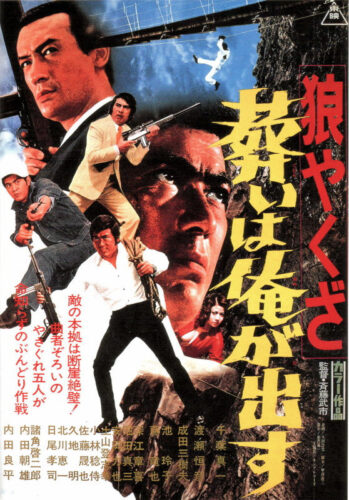
An arms deal goes sideways and dealer Ibuki has his weapons taken by the guy he was supposed to be selling to, yakuza man Semba who works for Sakurada. Ibuki’s mate Masao is shot dead and Ibuki ends up in prison, sentenced for five years. During that time Semba has risen to power before being deposed, and Ibuki’s girlfriend Mari has become the brutalised girlfriend of Kemba, once a corrupt cop who was sacked and is now a fully fledged gangster. Ibuki, along with a friend he made in prison named Goro is released, and he reunites with Mari, but soon realises that he and Hikawa can’t overthrow Sakurada and the Touoh-kai gang on their own own, so they go looking for help….
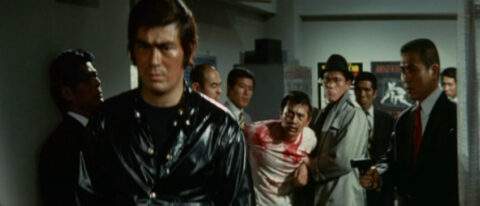
Yakuza Wolf 2: Extend My Condolences isn’t really a sequel to Yakuza Wolf: I Perform Murder. Sure, we’re still in the world of the yakuza, Chiba is again an avenger, and a few other cast members show up, but they’re all playing different characters to the ones they played in the first movie, which seems rather odd today, but decades ago sequels often did this sort of thing, attempting to drag people who loved a film into cinemas by giving the impression that a second film would deliver more of the same even if it was a bit different; sometimes films were retitled to make people think is. Extend My Condolences is lighter than I Perform Murder, though this certainly doesn’t mean that it lacks for violence or grimness, making for a film which shifts back and forth in tone, something that may annoy some viewers, though then again one of the things that some of us who got into Hong Kong cinema back in the day were attracted by was the way that these films were often bold enough to go anywhere they wanted, from goofy comedy to intense gunplay to cute romance. It’s not nearly as good a film as I Perform Murder, with there being far less tension on offer, and all the action of any length being relegated to the second half, though it’s still very nimble in its pacing. Director Buichi Saito doesn’t seem to be very interested in elevating the material he’s been given unlike Ryuichi Takamori, though he still does a solid job. As for Chiba, his performance and character seem to be somewhat transitional here. He speaks far more than he did in I Perform Murder, but is still more introverted than he would become in his iconic Streetfighter trilogy and some similar pictures. Likewise, despite subduing bad guys throughout which allows him to show some of his skill, he only gets one full-on fight scene unless you count a silly one while his character is in prison, and I’ll tell you right now that it’s a fight scene where he loses!
The loud noise of an airplane over the familiar Toei logo of water splashing on rocks is somewhat disconcerting, before we see the plane freeze framed so that the titles can appear. A jeep arrives at a back street; oddly the person who we see get out of it is a Caucasian. Inside a warehouse Chiba’s character Ibuki and his mate Masao are getting ready to sell these guns but these two gwaillos want them to raise the price [“you’re going to sell them to Japanese, they’re all gangsters anyway”], before in bursts Semba, a member of the Touoh-kai gang which is headed by Sakurada with Kemmochi second in command, and his men. Even though the deal was agreed upon for the next day, Semba is here now and is taking both the guns and the money now. The two yanks, whose role I’m still not sure of, flee, never to be seen again, while a shootout ensures. Semba and Masao try to get away, Chiba getting to knock a few men off a decent height before he [and I’m sure it’s him] swings on a rope through a glass window. At the same time the police turn up, headed by Kemba, who says “we got what we wanted”. This rather kinetic opening comes to a close when Masao is shot and dies in the arms of Ibuki, who’s then arrested. Kemba shows what a nasty guy he is when he tears up a dropped photograph of Masao with a lady. Is he really a proper cop? Hmmm, I wonder. Semba meets up with Kemmochi whom he considers to have made too many mistakes. “You aren’t our boss anymore” he cries before shooting him and his companion dead, after which we make a brief acquaintance with a lovely cinema device which was common in the movies of old Hollywood and was sometimes employed in Japanese gangster movies of the period; the newspaper montage, often with faces superimposed on the writing.
We now flash forward five years and see Ibuki in prison fighting another inmate for reasons I can’t quite discern; the brawl, which is mainly fisticuffs but does have Chiba with his head in a toilet at one point after which he gets to spit toilet water in the face of his opponent. Guards come along to subdue the tiny riot that’s been caused, while the two fighters immediately become friends. Goro not only offers him a job but knows of a way to escape. Of course Ibuki is able to offer him a more dangerous but far more lucrative job, leading to an overtly comedic sequence which doesn’t quite work where the attempted prison break is discovered and stopped in slow motion while on the soundtrack we hear a slow version of the Can-Can which then becomes really fast when the action speeds up too. However, Ibuki and Goro are still given an amnesty because of the “return of Okinawa”, something else which I don’t understand though no doubt viewers will more knowledge of Japan’s history will. The two are soon out, but almost immediately they’re ambushed by golfers who are actually killers, pulling rifles out of their bags, before being saved by Arakida, the brother of Masao, who for some reason often likes to go around in traditional Chinese garb. Arakida also likes to stay out of trouble, but Ibuki is now on a mission, though he soon realises that he will need help, so he and Goro go recruiting. Soon three guys: Hikawa, Tameji Okuma and his younger friend Yuki whom he had to save from three thugs and whom he thinks isn’t ready, join up, but Semba has long gone, Arakida having been behind Masao’s death anyway. But then there’s the matter of Mari, Ibuki’s once girlfriend who’s now in the possession of the abusive Kemba. And who’s the mysterious person who saves Ibuki at one point?
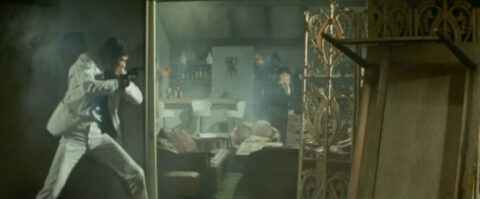
Chiba certainly gets to emote but it’s very controlled, and after seeing these two films I’m far more impressed by him as an actor. This Chiba character isn’t virtually invincible like the previous Yakuza Wolf; he needs helps and gets beaten in the afore-mentioned fight which is still a forerunner to many later Chiba fights, with quick moves amidst a lot of facing off while staffs, an axe and darts are employed. He ends up covered in blood and we get an memorable bit where he slowly pulls himself up off the ground by grabbing ever higher bars of a chair – but we’re unsatisfied because we don’t get the payoff or a rematch and the opponents disappear from the film. Elsewhere he does does dispatch a lot of people with his bare hands; a comic hallway chase and fight looks like it’s going to really develop into something but it never quite does, and we feel this way elsewhere in scenes which don’t fulfill their potential. Nonetheless he does get some chances to show off his athleticism, including hanging on to yet also moving along the bottom of a rope bridge, and he’s clearly doing nearly of this stuff himself, though we probably didn’t need a crazy wire-fu spin and fall during the final confrontation. Just before that we have a very small amount of hand to hand combat but mostly lots of gun carnage in a blazing display of people being shot, with Chiba given one cool moment where, after someone else has tried to grab a gun and failed, he leaps, grabs it, rolls and shoots a few opponents. The excitement provided by this proto-John Woo stuff is rather lessened by the direction of Saito, which generally lacks in much style except for some use of Dutch angles here and there and some rather Sergio Leone-esque introductions to three characters plus a confrontation. There’s still a lot of blood, in a story which, despite its very familiar components, does feel able to give us some tragedy; in fact I hope it’s not too much of a spoiler to say that eventually we wonder who’s going to die next.
Ibuki’s helpers all get their moments, though I want to see another film about Hikawa; the character is interesting in ways which Ryûzô Nakanishi’s screenplay only hints at. He’s introduced betting to Ibuki that he’ll win a fight against three men, which he does very quickly, breaking a few rips below the frame. There’s not enough of a team sensibility, and eventually two members are replaced because of a twist in the tale which doesn’t have the impact that it should; it’s one of several potentially strong moments which are rather weakly handled by Saito, who was clearly just doing a job, though he does seem invested in the character of Mari. This subplot is surprisingly emotional, aided immensely by an emotive performance by Reiko Ike. Ibuki and Mari are still in love with each other when he sneaks in and visits her. “I’m not the girl you used to know, I’m dirty, I’d rather be dead”, she says to him, but this doesn’t alter his feelings. We hate it when Kemba brutally whips her, something he clearly does often, before beginning to passionately lick her wounds and she seems to enjoy it. Ugh….though it’s not quite as graphic as you might expect. Nonetheless this is when things turn much more serious, though silly stuff does make comebacks, from bizarrely dressed villains, to a car pursuit being delayed by a school bus where the pursuers complain about it not letting them overtake even though the road is so narrow that they wouldn’t be able to overtake it anyway too. Gadgets certainly add to the fun, and there are some good character compositions plus no “shakycam” this time, but coming after I Perform Murder, much of Extend My Condolences seems a bit ordinary by comparison, and an oft-used final twist adds little since it’s handled in a rather perfunctory fashion.
Taiichirô Kosugi’s musical score has its dynamic passages, while the theme song sung by Chiba himself is a recurring tune. A trumpet melody comes in at around an hour in to memorable effect. Extend My Condolences contains a lot to enjoy alright, but the trouble is that it followed I Perform Murder, and its inferiority can’t help but be therefore made extremely obvious. On its own it’s a pretty capable example of its genre.
Rating: 









“YAKUZA WOLF: EXTEND MY CONDOLENCES” SPECIAL FEATURES
1080p presentation, from a new restoration of the original film elements by Toei
This looks virtually the same as the first one: I say “virtually” because blacks seem slightly deeper and obviously there aren’t any “shakycam” shots which often seem to look inferior.
Original Japanese mono audio
Optional English Subtitles
Brand new audio commentary by Mike Leeder and Arne Venema
If anything this track, which begins with Venema explaining where the Toei logo was shot, is better than the previous one, and actually seems to have a bit more of Venema than Leeder for a change. Both of them think that the film changed director at some point or assistant directors did stuff because of the huge tonal shifts. We also learn that it’s Chiba’s real voice speaking in English at the beginning, and that the rolling Rs you often hear in these movies was gangster lingo showing aggressiveness. And for the second time in this set, Leeder mentions GI Samurai, a film which I love too and ought to do a review of. The duo don’t actually say this, but they seem to enjoy the second part as much as the first. It was great to hear them do talk tracks on two Japanese movies and I hope that they do more.
Original theatrical trailer
SPECIAL FEATURES
Limited Edition O-Card slipcase featuring new artwork by Chris Malbon [2000 copies]
A Limited Edition collector’s booklet featuring new writing by Tom Mes and Howard Hughes [2000 copies]
More Chiba goodness from Eureka. As is often the case, the audio commentaries offer considerable added value. Highly Recommended!


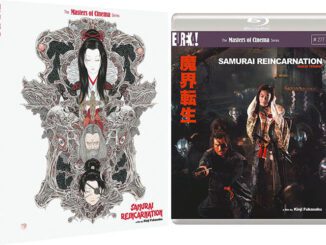
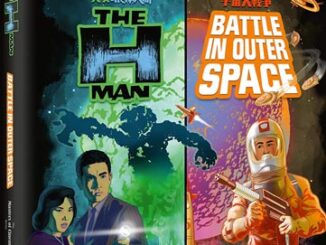
Be the first to comment